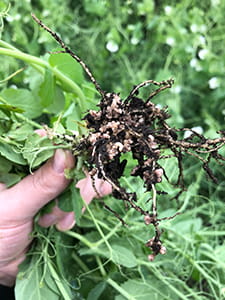By Tyce Masich, BSc, Crops Extension Specialist, Outlook
February 2024
.jpg?h=300&w=206&hash=666A3AD953CC60F628BAA7885EF99E2D)
Pea leaf weevils are traditionally found in the warmer regions of southern Alberta and Saskatchewan; however, in recent years, it has been spreading to northern cropland regions of the prairies and east into Manitoba.
In 2023, Saskatchewan had low populations in the southwest and central west regions of the province, likely due to the severe drought conditions in 2023. Populations were higher in the northwest, northeast and eastern regions of the province as there was more moisture in these areas relative to the rest of the province during the 2023 growing season. Some areas in the north such as parts of RM 394, 486, 488 and 501 were not surveyed despite being adjacent to high populations; therefore, it is important that farmers in this area scout their legume fields for activity in 2024.
Environmental conditions throughout the growing season affect pea leaf weevil populations and potential yield losses. If there are persistent warm temperatures over 20 C in late April or early May, they can emerge from its overwintering sites and attack young pea and faba bean crops. This early activity can result in higher yield losses as they will lay eggs early in the growing season and the larvae will be able to attack smaller and less vigorous plants. Wet and cool spring conditions inhibit activity early in the growing season, which can reduce yield losses. Furthermore, crops are less susceptible to damage in dry soil conditions as eggs and larvae activity is hindered.

When adults feed on legume plants, they create notches on the leaf margins of susceptible crops, which is an indication of pea leaf weevil activity in your area. If you find these notches in any of your legume crops, it is important to scout the roots of your pea and faba bean crops for larvae feeding on the root nodules. When looking for leaf notches, it’s important to look carefully at the crop as damage from other insects can be confused with notching from the pea leaf weevil.
Visit the Pea Leaf Weevil page for more information on pea leaf weevil and to view the 2023 survey map. For agronomic advice and information, contact your local crops extension specialists or call the Agriculture Knowledge Centre at 1-866-457-2377.
